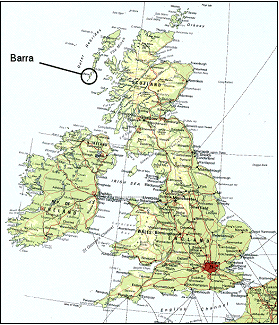|
Back to previous page
The Assembly of Indirect Evidence for RUAIRIDH BREAC MACNEIL — "THERE WAS A SOLDIER . . . ."
His BIRTH —
Was Ruairidh Breac originally from Barra, Scotland? When?
Ruairidh Breac was a Barraman stands as an undisputed fact. His birthplace is the island of pre-Cambrian rock that sits like a fist at the southern end of the Hebridean chain. It is about eight miles in length and from two to four miles in width: complicated miles as the sea has cut long deep fissures and grooves into the coast. The high, 1000-foot hills of Beinn Sheabhal and Tangabhal offer footholds for the sheep, and for the sea birds—this last bit of land offers rest before the Atlantic stretches almost 2000 miles across to North America. In the 1790s, the number of people on Barra were counted by the Statistical Account as "760 males and 864 females".1 There is no place for strangers on Barra.
During the fifty-year interlude between the 1780s and 1840s, hundreds of emigrants set sail from Barra, most of them destined for Eastern Nova Scotia, and certainly during that half century they all would have been well connected within four or five degrees of separation. They were extended families, relatives, friends and neighbours. To them, Ruairidh Breac MacNeil was known as a Barraman, named as so. Knowledge that he came from there was not contradicted then, and it has not been since. This indirect evidence is like a seal that forms the link between his identity and his society.
Yet, only by establishing whether this Ruairidh MacNeil was a Scottish soldier in the American war will it be possible to calculate his age. According to an act of the British parliament (18 Geo. III, C. 53), no person should be enlisted "who should appear in the opinion of the ... Officers ... to be under the Age of seventeen Years, above the Age of forty-five Years, or who should be under the Size of five Feet, four Inches without Shoes."2 Thus, military history should help in estimating a biographical timeline for Ruairidh Breac, but his birthplace, Barra, still offers daunting genealogical challenges.
There are neither civil nor parish records that are reliable for Barra in the mid 18th century. Until the end of the Jacobite cause,3 the island society was
 |
organized as a feudal estate or fiefdom, and the language spoken by the people was Gaelic. The uprisings against the English in the first half of the 1700s debilitated the Highlands and islands of Scotland (Jacobean Rebellions 1715 and 1745); Clan MacNeil felt the effects of these insurgent adventures, although neither the island nor the clan played a major role. In the aftermath, all of the clans in Scotland were caught up in the jealousies among the chieftains and the resulting shifts in family alliances, for, following the '45, the Duke of Cumberland slammed the door to all further rebellion essentially by stripping the chiefs of their feudal power and influence. Certainly, between 1740 and 1760, the years when it is most plausible Ruairidh Breac McNeil would have been born on Barra, there was no government agency or clerk keeping official records of births, marriages and deaths. The prospect of a civil record of any kind is faint, at best.
Religious clerics, keepers of parish registers and diocesan statistics offer the next best hope for finding a baptism record at least, but religious customs in Barra present another set of problems. This was the last place in Scotland to cling to the Old Faith. From 1560, the Catholic religion was disallowed anywhere in Scotland, although more than 100 years after the ban, in a report on the Scottish missions in 1669, the Apostolic Prefect stated—
The Catholics live in peace in the islands of Uist and Barra . . . which are the most remote from the government residences. Such is the severity of the laws that the practice of the Catholic religion is not allowed; in the Highlands and remote islands, however, these laws are not carried into execution. The Highland families are, for the most part, Catholic or prepared to be so, if they had priests to instruct them.4
Moreover, the MacNeils on Barra were notorious for their self-reliance; for another hundred years, even until the mid-1700s, the chief and his clansmen, generally without benefit of clergy, practiced their own interpretation of the liturgy. It was the last gasp in the Hebrides. John Lorne Campbell, in his essay, "Barra in the Forty-Five" recounts a story of 1746 when the English Captain Scott "landed in Barra to search for arms and hanged a man whom he heard had been in arms". A Presbyterian minister on the island, lamenting the slow progress of the Reformation, adds to this story:
In the islands belonging to MacNeil of Barra although there be about 400 or 500 souls, there is but one gentleman and 7 or 8 common people are Protestants, of whom the poor unfortunate man [whom Captain Scott had hanged] was one.5
Priests were just not available. In the unlikely chance that any services were held in the 18th century, the accounts and credits were kept hidden from the authorities; sacraments that might have been written in a parish register, if they were written, were concealed. In the 250 years since, no church register has been brought to light that may hold nominal evidence of Catholic baptisms, marriages or deaths in Barra in the 1740s or '50s—the most likely interval for the birth of Ruairidh, if he was to become a member of the British Army in the 1770s. And, regardless of the Old Faith, when Scottish men were sworn into the British Army, they were sworn and declared as true followers of the Protestant religion.6
Continue . . .
|
